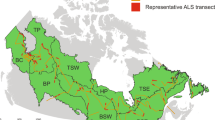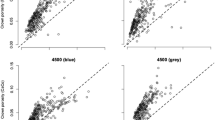Abstract
The opening and closure of “gaps” in forest canopies plays an important role in the structure, turnover, and overall ecological processes of natural forests. Gap characterization was until recently mostly based on field studies and relied on sampling approaches. ALS (Airborne Laser Scanning) has now revolutionized this field of scientific enquiry by giving researchers the capacity to detect and measure gaps rapidly over large areas. We first provide a brief scientific background on gaps and then succinctly review field and other conventional remote sensing methods to characterize them. We then turn our attention to the principles of ALS-based gap detection and review different methods of automated gap delineation and measurement. We explain how gap types can be automatically classified, and how multitemporal ALS can be used to not only monitor gap dynamics, but also to reveal the complex role of gaps in influencing tree growth within and around them.
Access this chapter
Tax calculation will be finalised at checkout
Purchases are for personal use only
Similar content being viewed by others
Notes
- 1.
Not be confused with the smaller scale foliage “gap fraction” measured from hemispherical photographs or terrestrial laser scanning (see Chap. 20).
References
Andersen H-E, McGaughey RJ, Carson WW, Reutebuch SE, Mercer B, Allan J (2003) Acomparison of forest canopy models derived from LIDAR and IFSAR data in a Pacific Northwest conifer forest. In: Proceedings, ISPRS working group III/3 workshop “3-D reconstruction from airborne laser scanner and InSAR data”, Dresden, Germany, 8–10 October 2003, pp 211–217
Arp H, Tranarg C (1982) Mapping in tropical forests: a new approach using the laser APR [Airborne Profile Recorder]. Photogramm Eng Remote Sens 48:91–100
Asner GP, Kellner JR, Kennedy-Bowdoin T, Knapp DE, Anderson C, Martin RE (2013) Forest canopy gap distributions in the southern Peruvian Amazon. PLoS ONE 8(4):e60875. doi:10.1371/journal.pone.0060875
Bergeron Y, Fenton N (2012) Boreal forests of eastern Canada revisited: old growth, nonfire disturbances, forest succession, and biodiversity. Botany 90:509–523
Betts HD, Brown LJ, Stewart GH (2005) Forest canopy gap detection and characterisation by the use of high-resolution Digital Elevation Models. N Z J Ecol 29:95–103
Chen HY, Popadiouk RV (2002) Dynamics of North American boreal mixedwoods. Environ Rev 10:137–166
Coates DK, Burton PJ (1997) A gap-based approach for development of silvicultural systems to address ecosystem management objectives. For Ecol Manage 99:337–354
Denslow JS, Spies T (1990) Canopy gaps in forest ecosystems: an introduction. Can J For Res 20:619
Fujita T, Itaya A, Miura M, Manabe T, Yamamoto SI (2003) Long-term canopy dynamics analysed by aerial photographs in a temperate old-growth evergreen broad-leaved forest. J Ecol 91:686–693
Gagnon JL, Jokela EJ, Moser WK, Huber DA (2004) Characteristics of gaps and natural regeneration in mature longleaf pine flatwoods ecosystems. For Ecol Manage 187:373–380
Gaulton R, Malthus TJ (2010) LiDAR mapping of canopy gaps in continuous cover forests: a comparison of canopy height model and point cloud based techniques. Int J Remote Sens 31:1193–1211
Goovaerts P (1997) Geostatistics for natural resources evaluation, Applied geostatistics. Oxford University Press, New York
Hu L, Zhu J (2009) Determination of the tridimensional shape of canopy gaps using two hemispherical photographs. Agric For Meteorol 149:862–872
Jung J, Pekin BK, Pijanowski BC (2013) Mapping open space in an old-growth, secondary-growth, and selectively logged tropical rainforest using discrete return LIDAR. IEEE J Sel Top Appl Earth Obs Remote Sens 6:2453–2461. doi:10.1109/jstars.2013.2253306
Kane VR, Gersonde RF, Lutz JA, McGaughey RJ, Bakker JD, Franklin JF (2011) Patch dynamics and the development of structural and spatial heterogeneity in Pacific Northwest forests. Can J For Res 41:2276–2291
Kellner JR, Asner GP (2009) Convergent structural responses of tropical forests to diverse disturbance regimes. Ecol Lett 12:887–897
Kneeshaw DD, Bergeron Y (1998) Canopy gap characteristics and tree replacement in the Southeastern Boreal Forest. Ecology 79:783–794
Kneeshaw DD, Gauthier S (2003) Old-growth in the boreal forest at stand and landscape levels. Environ Rev 11:s99–s114
Kneeshaw D, Bergeron Y, Kuuluvainen T (2011) Forest ecosystem structure and disturbance dynamics across the circimboreal forest. In: Millington A, Blumler M, Schickhoff U (eds) The SAGE handbook of biogeography. Sage, London
Koukoulas S, Blackburn GA (2004) Quantifying the spatial properties of forest canopy gaps using LiDAR imagery and GIS. Int J Remote Sens 25:3049–3072
Krabill W, Collins J, Link L, Swift R, Butler M (1984) Airborne laser topographic mapping results. Photogramm Eng Remote Sens 50:685–694
Latif ZA, Blackburn GA (2010) Extraction of gap and canopy properties using LiDAR and multispectral data for forest microclimate modelling. In: 2010 6th international Colloquium on Signal Processing & Its Applications (CPSA), Melaka, Malaysia, 21–23 May 2010. IEEE Malaysia Section, pp 1–5
Lertzman KP, Sutherland GD, Inselberg A, Saunders SC (1996) Canopy gaps and the landscape mosaic in a coastal temperate rain forest. Ecology 77:1254–1270
McCarthy J (2001) Gap dynamics of forest trees: a review with particular attention to boreal forests. Environ Rev 9:1–59
Messier C, Doucet R, Ruel JC, Claveau Y, Kelly C, Lechowicz MJ (1999) Functional ecology of advance regeneration in relation to light in boreal forests. Can J For Res 29:812–823
Miller DR, Quine CP, Hadley W (2000) An investigation of the potential of digital photogrammetry to provide measurements of forest characteristics and abiotic damage. For Ecol Manage 135:279–288
Nakashizuka T, Katsuki T, Tanaka H (1995) Forest canopy structure analyzed by using aerial photographs. Ecol Res 10:13–18
Nelson R, Krabill W, MacLean G (1984) Determining forest canopy characteristics using airborne laser data. Remote Sens Environ 15:201–212
Paré D, Bergeron Y (1995) Above-ground biomass accumulation along a 230-year chronosequence in the southern portion of the Canadian boreal forest. J Ecol 83:1001–1007
Pham AT, Grandpré LD, Gauthier S, Bergeron Y (2004) Gap dynamics and replacement patterns in gaps of the northeastern boreal forest of Quebec. Can J For Res 34:353–364
Pickett STA, White PS (1985) The ecology of natural disturbance and patch dynamics. Academic, San Diego
Royo AA, Carson WP (2006) The formation of dense understory layers in forests worldwide: consequences and implications for forest dynamics, biodiversity, and succession. Can J For Res 36:1345–1362
Runkle JR (1985) Disturbance regimes in temperate forests. In: Pickett STA, White PS (eds) The ecology of natural disturbance and patch dynamics. Academic, San Diego
Runkle JR (1992) Guidelines and sampling protocol for sampling forest gaps. USDA Forest Service Pacific Northwest Research Station general technical report PNW-GTR-283, Portland, Oregon, USA
Schliemann SA, Bockheim JG (2011) Methods for studying treefall gaps: a review. For Ecol Manage 261:1143–1151
Sénécal J-F (2011) Dynamique spatio-temporelle des trouées en forêt feuillue tempérée par télédétection Lidar. Dissertation, Université du Québec à Montréal, Montréal, QC, Canada
Sénécal J-F, Doyon F, St-Onge B (2010) Is it possible to predict gap age in North American temperate deciduous forest using LiDAR data? In: Proceedings of SilviLaser 2010: the 10th international conference on LiDAR applications for assessing forest ecosystems, Freiburg, Germany, 14–17 September 2010, pp 99–108
Seymour RS, White AS, deMaynadier PG (2002) Natural disturbance regimes in northeastern North America – evaluating silvicultural systems using natural scales and frequencies. For Ecol Manage 155:357–367
St-Denis A, Kneeshaw D, Bergeron Y (2010) The role of gaps and tree regeneration in the transition from dense to open black spruce stands. For Ecol Manage 259:469–476
St-Onge B, Vepakomma U (2004) Assessing forest gap dynamics and growth using multi-temporal laser scanner data. In: Proceedings of the laser-scanners for forest and landscape assessment – instruments, processing methods and applications international conference, Frieburg im Breisgau, 3–6 October 2004, pp 173–178
Tanaka H, Nakashizuka T (1997) Fifteen years of canopy dynamics analyzed by aerial photographs in a temperate deciduous forest, Japan. Ecology 78:612–620
Tarroux E, DesRochers A (2011) Effect of natural root grafting on growth response of jack pine (Pinus banksiana; Pinaceae). Am J Bot 98:967–974
Vastaranta M, Korpela I, Uotila A, Hovi A, Holopainen M (2012) Mapping of snow-damaged trees based on bitemporal airborne LiDAR data. Eur J For Res 131:1217–1228
Vehmas M, Packalén P, Maltamo M (2009) Assessing deadwood existence in canopy gaps by using ALS data. In: Proceedings of Silvilaser 2009, College Station, Texas, USA, 7 p
Vehmas M, Packalén P, Maltamo M, Eerikäinen K (2011) Using airborne laser scanning data for detecting canopy gaps and their understory type in mature boreal forest. Ann For Sci 68:825–835
Vepakomma U, Fortin MJ (in review) Optimising lidar return density to understand forest dynamics – a study using an event-based approach
Vepakomma U, St-Onge B, Kneeshaw D (2008) Spatially explicit characterization of boreal forest gap dynamics using multi-temporal lidar data. Remote Sens Environ 112:2326–2340
Vepakomma U, St-Onge B, Kneeshaw DD (2010) Interactions of multiple disturbances in shaping boreal forest dynamics – a spatially explicit analysis using multi-temporal lidar data and high resolution imagery. J Ecol 98:526–539
Vepakomma U, St-Onge B, Kneeshaw DD (2011) Boreal forest height growth response to canopy gap openings – an assessment with multi-temporal lidar data. Ecol Appl 21:99–121
Vepakomma U, Kneeshaw D, Fortin MJ (2012) Spatial contiguity and continuity of canopy gaps in mixed wood boreal forests: persistence, expansion, shrinkage and displacement. J Ecol 100:1257–1268
Yamamoto SI (1992) The gap theory in forest dynamics. Bot Mag Tokyo 105:375–383
Yu X, Hyyppä J, Kaartinen H, Maltamo M (2004) Automatic detection of harvested trees and determination of forest growth using airborne laser scanning. Remote Sens Environ 90:451–462
Yu X, Hyyppä J, Kaartinen H, Hyyppä H, Maltamo M, Rönnholm P (2005) Measuring the growth of individual trees using multi-temporal airborne laser scanning point clouds. In: Proceedings of the ISPRS workshop “Laser scanning 2005”, Enschede, The Netherlands, 12–14 September 2005, pp 12–14
Zhang K (2008) Identification of gaps in mangrove forests with airborne LIDAR. Remote Sens Environ 112:2309–2325
Author information
Authors and Affiliations
Corresponding author
Editor information
Editors and Affiliations
Rights and permissions
Copyright information
© 2014 Springer Science+Business Media Dordrecht
About this chapter
Cite this chapter
St-Onge, B., Vepakomma, U., Sénécal, JF., Kneeshaw, D., Doyon, F. (2014). Canopy Gap Detection and Analysis with Airborne Laser Scanning. In: Maltamo, M., Næsset, E., Vauhkonen, J. (eds) Forestry Applications of Airborne Laser Scanning. Managing Forest Ecosystems, vol 27. Springer, Dordrecht. https://doi.org/10.1007/978-94-017-8663-8_21
Download citation
DOI: https://doi.org/10.1007/978-94-017-8663-8_21
Published:
Publisher Name: Springer, Dordrecht
Print ISBN: 978-94-017-8662-1
Online ISBN: 978-94-017-8663-8
eBook Packages: Biomedical and Life SciencesBiomedical and Life Sciences (R0)




